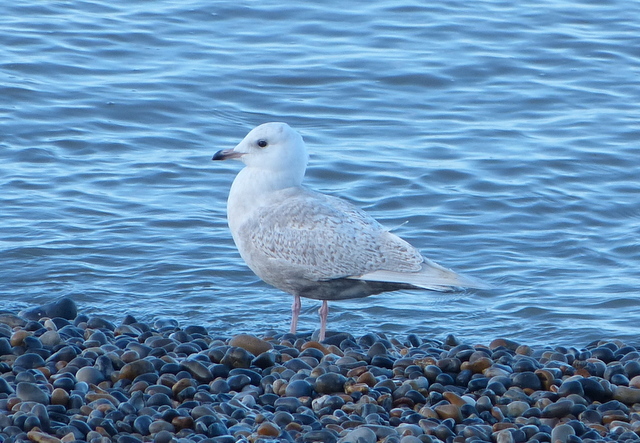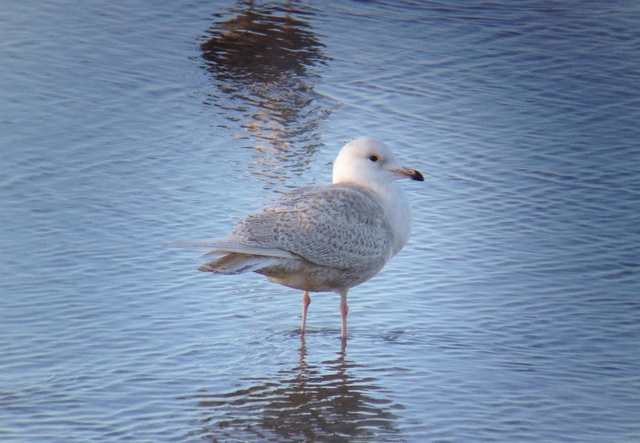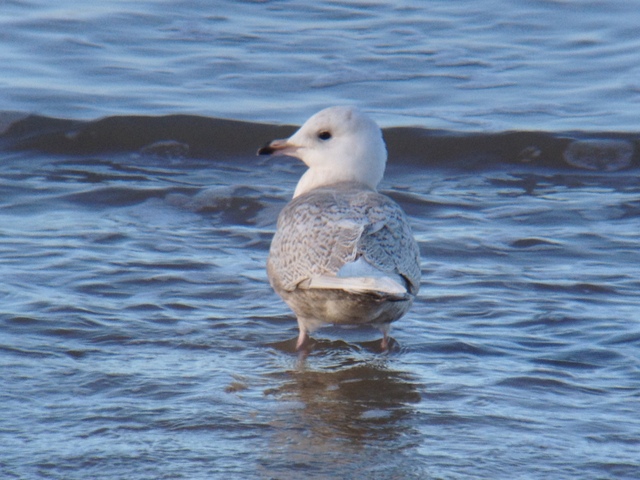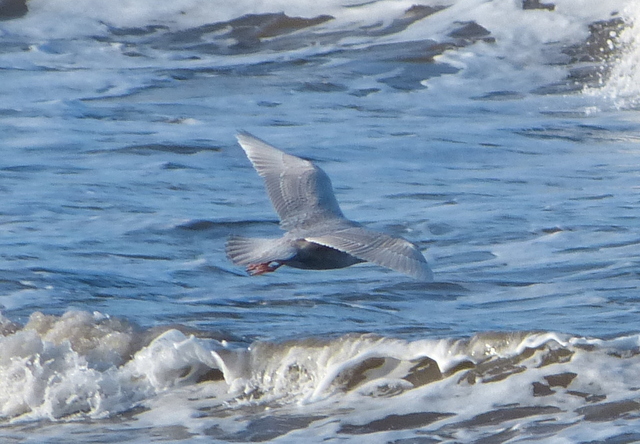Iceland Gull is a bird which is hard to see in Norfolk, and Glaucous Gull is not as regular as it used to be either. Both are visitors from the arctic – ironically, Iceland Gull comes from Canada and Greenland and not Iceland; Glaucous Gull does breed in Iceland, and elsewhere all round the northern hemisphere. The news that both an Iceland and a Glaucous Gull were on the beach together at Sheringham certainly merited a look.
There was a vast throng of gulls all along the beach. The stormy northerly winds over the weekend had washed up a mess of dead fish, starfish, whelk egg cases, and other sea-borne detritus. The gulls had gathered to feed on the bounty, though watching gulls attempting to swallow large starfish left you wondering why they had bothered! There was an enormous number of Herring Gulls of all ages, fewer Great Black-backed Gulls amongst them, and loads of Common and Black-headed Gull as well. Wherever large gulls gather it is always worth having a look through for something more interesting.
The Glaucous Gull was immediately visible on arrival, standing on the beach. Glaucous is a big, heavy, powerful gull, significantly bigger than a Herring Gull and approaching Great Black-backed in size. This one was a juvenile, with a distinctive pale biscuit-coloured plumage and long bill with distinctive pink base and ‘dipped in ink’ black tip. Like Iceland Gull, and unlike our other regular large gulls, it has no black in the wingtips which are actually paler than the body plumage. A smart bird.
 Glaucous Gull – a big juvenile on the beach
Glaucous Gull – a big juvenile on the beach
Just as I arrived, however, the Iceland Gull decided to fly off along the beach. There was another feeding frenzy further west, so a small group of us set off along the prom and out along the beach to try to find it. By the time we got there, it had already been relocated out on the sand. Even from some distance, it stood out – a very pale gull, distinctly smaller than a Herring Gull and more elegant than the brute of the Glaucous Gull with rounded head, more delicate bill and longer wings. It was hard to see the iris colour clearly – 2nd winters tend to have a paler iris, whereas juvenile/1st winter birds have a dark eye. The body plumage looked patchy white with some slightly darker feathering and the bill had an extensive pale base, consistent with a 2nd winter. We watched it distantly, standing on the beach, before it was flushed by a dog walker and flew out onto the sea.
 Iceland Gull – a 2nd winter, very pale, almost white
Iceland Gull – a 2nd winter, very pale, almost white
As some of the gulls started to filter back to the sand, we picked up the Glaucous Gull again, presumably the same bird having flown along the beach. Scanning the flocks, we also found some other gulls amongst the hordes – an adult Mediterranean Gull, just starting to acquire its black head, whirling over the beach (showing off its white-wings as well) and a dark-backed, white-headed adult Yellow-legged Gull on the sea.
Eventually we found what we initially presumed was the same Iceland Gull, out on the sea, preening and being tossed around by the waves. It gradually drifted towards us, then took off and flew back east along the shoreline. We walked back and found it on the beach – but surely this was a juvenile/1st winter, with a dark iris and quite mottled body plumage, the black of the bill tip bleeding back along the cutting edges. Back at base, comparing photos of the bird from earlier in the afternoon, it was easier to confirm that there were indeed at least two Iceland Gulls present – a 2nd winter and a juv/1st winter. A video of this bird can be seen HERE.


 Iceland Gull – this one a juv/1st winter, a second bird
Iceland Gull – this one a juv/1st winter, a second bird
 Iceland Gull – juv/1st winter in flight, showing off its pale wing tips
Iceland Gull – juv/1st winter in flight, showing off its pale wing tips
Not a bad haul – 8 different species of gull on the beach and at least three different white-wingers – a Glaucous and two Icelands. That is a very good return indeed for Norfolk these days.
















